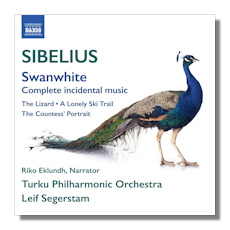
The Internet's Premier Classical Music Source
Related Links
- Sibelius Reviews
- Latest Reviews
- More Reviews
-
By Composer
-
Collections
DVD & Blu-ray
Books
Concert Reviews
Articles/Interviews
Software
Audio
Search Amazon
Recommended Links
Site News
 CD Review
CD Review
Jean Sibelius

- Swanwhite, JS 189 (Complete Incidental Music)
- The Lizard, Op. 8 (Complete Incidental Music)
- A Lonely Ski Trail (Ett ensamt skidspar), JS 77b *
- The Countess' Portrait (Grevinnans konterfej), JS 88 *
* Riho Eklundh, narrator
Turku Philharmonic Orchestra/Leif Segerstam
Naxos 8.573341 63:34
When you think of Sibelius you think of his symphonies, tone poems and violin concerto. But he was actually prolific in many genres, including song, piano works, and incidental music for plays. It is the latter category into which the scores on for Swanwhite and The Lizard fit. The other two works are also in that same vein, but are much shorter, actually miniatures.
Swanwhite (1908), written to accompany the August Strindberg play of the same name, is scored for an orchestra of thirteen according to the album notes and other sources, but the ensemble on this disc sounds somewhat larger: I hear a reduced but still healthy compliment of strings as well as French horn, flute, clarinet and kettle drum. An organ is used in the last two movements, but I gather it's not counted among the instruments in the orchestra. Whatever the case, the music is subdued throughout its nearly half-hour length, from the horn call opening to the glorious organ-underpinned closing number. Though the notes suggest the influence of Grieg, the music sounds like Sibelius to these ears, even if hints of Peer Gynt and Holberg do vaguely appear. There are fourteen numbers, three lasting twenty seconds or less. The music is mostly pleasant, though there are many dramatic and serious moments that accompany the story of a princess (Swanwhite) and her love for a young prince who dies but is miraculously resurrected at the end.
The score for The Lizard (1909), which Sibelius wrote for the Mikael Lybeck play of the same name, is rather different from that of Swanwhite in that it consists of just two numbers, the first lasting just under four minutes and the latter about twenty-two. It is scored for a group of nine strings. The story involves good-versus-evil conflict and a love triangle: two women, Elsiv (good) and Adla (evil), vie for the love of Count Alban. Elsiv perishes in a fall caused by Adla and in revenge Alban pushes Adla off a balcony to her death. The music is quite somber throughout, often exhibiting the kind of moods that permeate Sibelius' Fourth Symphony. It is also unrelentingly slow and often sounds as though it is meant to serve as mere background music, rather than be heard in concert. Still, much of it is quite good and Sibelius completists will want this rarely performed music.
A Lonely Ski Trail (1948) was scored for piano and narrator, but the version used here is a bigger one for strings, harp and narrator. The Countess' Portrait (1905) is scored for strings and narrator. Both performances here last under five minutes and, as you would expect from the size of the ensembles, the music is subdued but also somewhat somber. The narrator often speaks over the music, and the language of the text is Swedish. Again, completists will want these performances, but others may not find them of great interest.
Leif Segerstam, himself a prolific composer, and the Turku Philharmonic Orchestra have received much acclaim for their recordings in this series of rarely performed Sibelius works. They deliver the music here with feeling and total commitment, making the best possible case for music that may not have been meant for the concert hall. Naxos provides excellent sound reproduction and the notes by Dominic Wells are informative.
Copyright © 2015, Robert Cummings





















